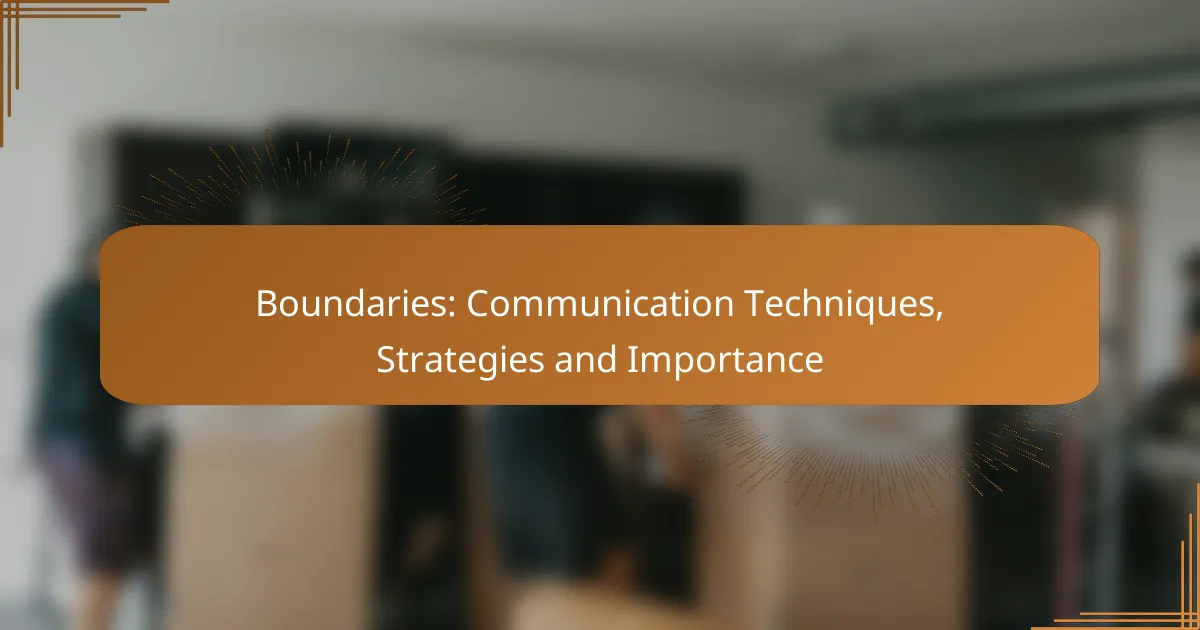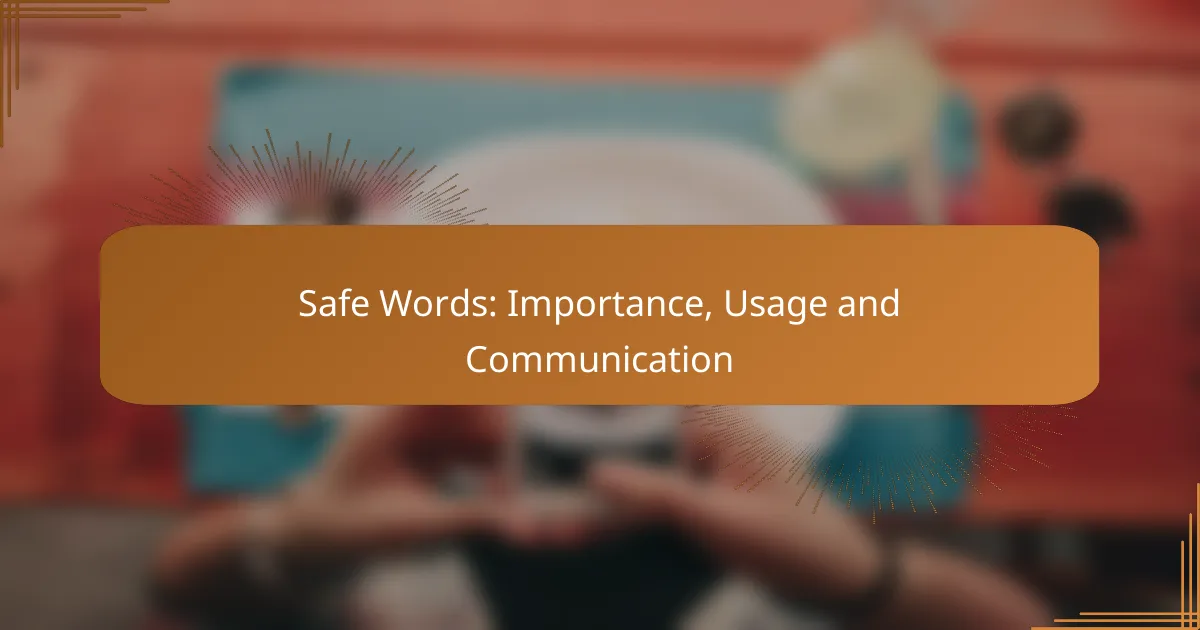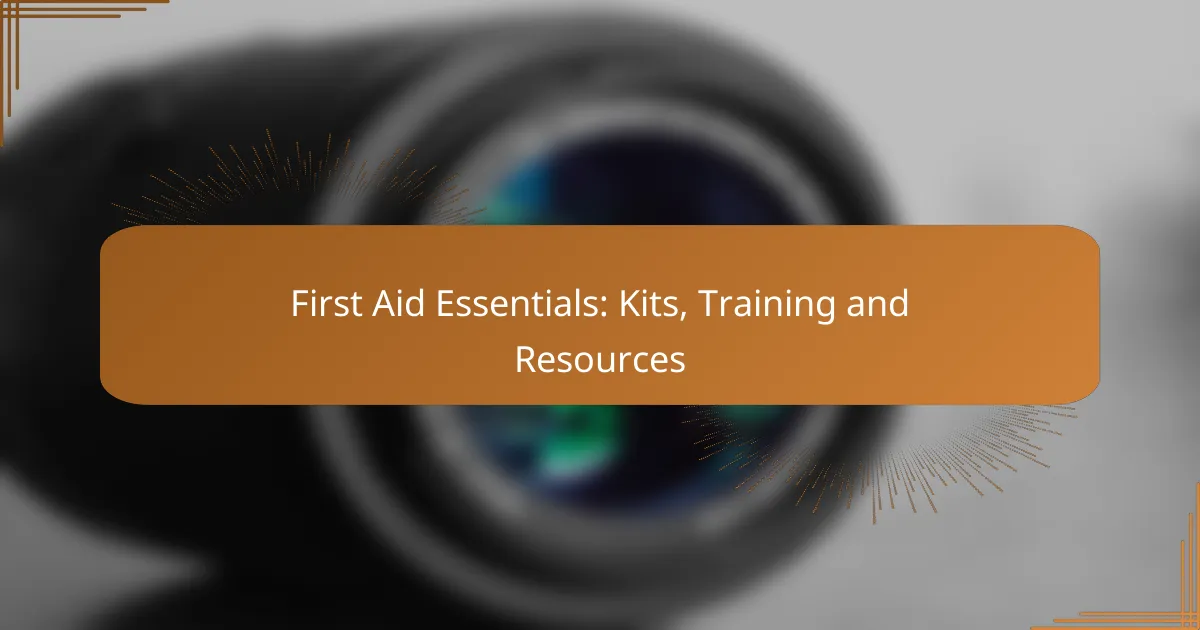Establishing boundaries is essential for effective communication in both personal and professional settings. By employing techniques such as active listening and assertive communication, individuals can express their needs while fostering mutual respect. Clear boundaries not only enhance relationships but also contribute to a more productive and respectful environment.
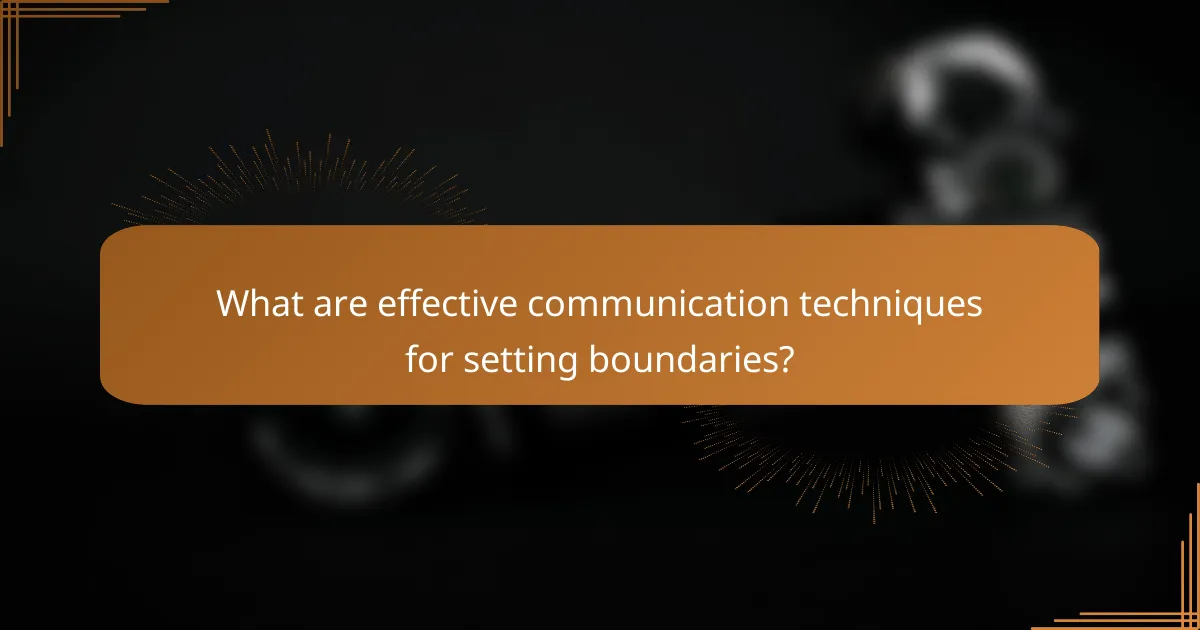
What are effective communication techniques for setting boundaries?
Effective communication techniques for setting boundaries include active listening, assertive communication, and the use of non-verbal cues. These strategies help individuals express their needs clearly while respecting others’ perspectives, fostering healthier interactions.
Active listening
Active listening involves fully concentrating on what the other person is saying, rather than just passively hearing their words. This technique requires you to acknowledge their feelings and clarify any misunderstandings, which can strengthen your boundary-setting efforts.
To practice active listening, maintain eye contact, nod in agreement, and paraphrase what the speaker has said. This shows that you value their input and are committed to understanding their viewpoint.
Assertive communication
Assertive communication is the ability to express your thoughts and feelings confidently and respectfully. It allows you to state your boundaries clearly without being aggressive or passive, which is crucial for effective boundary-setting.
Use “I” statements to express your needs, such as “I feel overwhelmed when…” This approach minimizes defensiveness and encourages open dialogue about boundaries.
Non-verbal cues
Non-verbal cues, such as body language and facial expressions, play a significant role in communication. Being aware of your own non-verbal signals, as well as those of others, can enhance your ability to set boundaries effectively.
For instance, maintaining an open posture and using appropriate gestures can convey confidence and openness. Conversely, crossed arms or avoiding eye contact may signal discomfort or defensiveness, undermining your message.
Empathy in conversations
Empathy involves understanding and sharing the feelings of others, which can facilitate more effective communication when setting boundaries. By acknowledging the emotions of those involved, you create a supportive environment for discussing limits.
To practice empathy, try to put yourself in the other person’s shoes and validate their feelings. This can help reduce tension and foster mutual respect during boundary-setting discussions.
Clear language
Using clear language is essential for effective communication when setting boundaries. Avoid vague terms and be specific about your needs and limits to prevent misunderstandings.
For example, instead of saying “I need some space,” specify “I need an hour alone after work to recharge.” This clarity helps others understand your boundaries and reduces the likelihood of conflict.
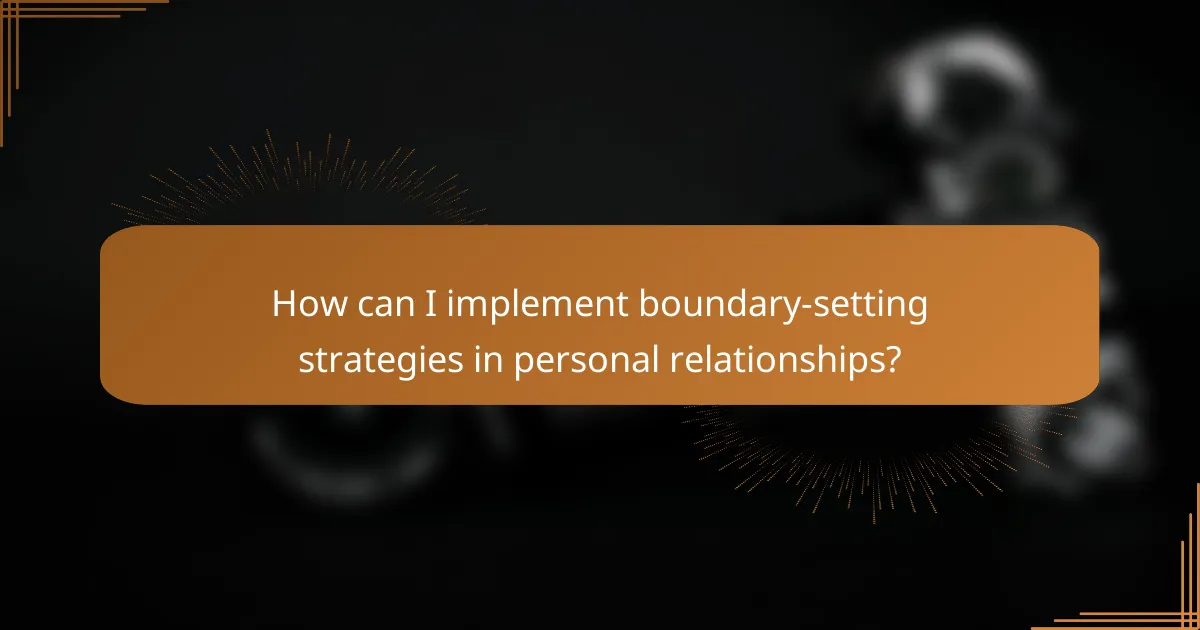
How can I implement boundary-setting strategies in personal relationships?
Implementing boundary-setting strategies in personal relationships involves recognizing your limits and expressing them clearly to others. This process fosters mutual respect and understanding, allowing for healthier interactions.
Identify personal limits
Identifying personal limits is the first step in setting boundaries. Reflect on what makes you uncomfortable or stressed in relationships, whether it’s time commitments, emotional demands, or physical space. Consider writing down these limits to clarify your thoughts.
Once you have a clear understanding of your limits, prioritize them based on their importance to your well-being. This can help you communicate effectively when boundaries are tested.
Communicate openly
Open communication is essential for establishing boundaries. Share your limits with those close to you in a calm and direct manner. Use “I” statements to express how certain behaviors affect you, such as “I feel overwhelmed when plans change last minute.”
Encourage dialogue by inviting others to share their perspectives. This two-way communication can enhance understanding and lead to more respectful interactions.
Practice saying no
Learning to say no is a crucial skill in boundary-setting. Start with small refusals to build your confidence, such as declining invitations that don’t align with your priorities. Remember, saying no is not selfish; it’s a way to protect your time and energy.
When practicing, be firm yet polite. You can say, “I appreciate the offer, but I can’t commit to that right now.” This approach helps maintain respect while asserting your boundaries.
Establish consequences
Establishing consequences for boundary violations is important for maintaining respect in relationships. Clearly communicate what will happen if your boundaries are crossed, such as needing to take a step back from the relationship or limiting contact.
Be consistent in enforcing these consequences. If you allow boundaries to be ignored without repercussions, it may lead to further violations and resentment. This consistency reinforces the importance of your limits to others.
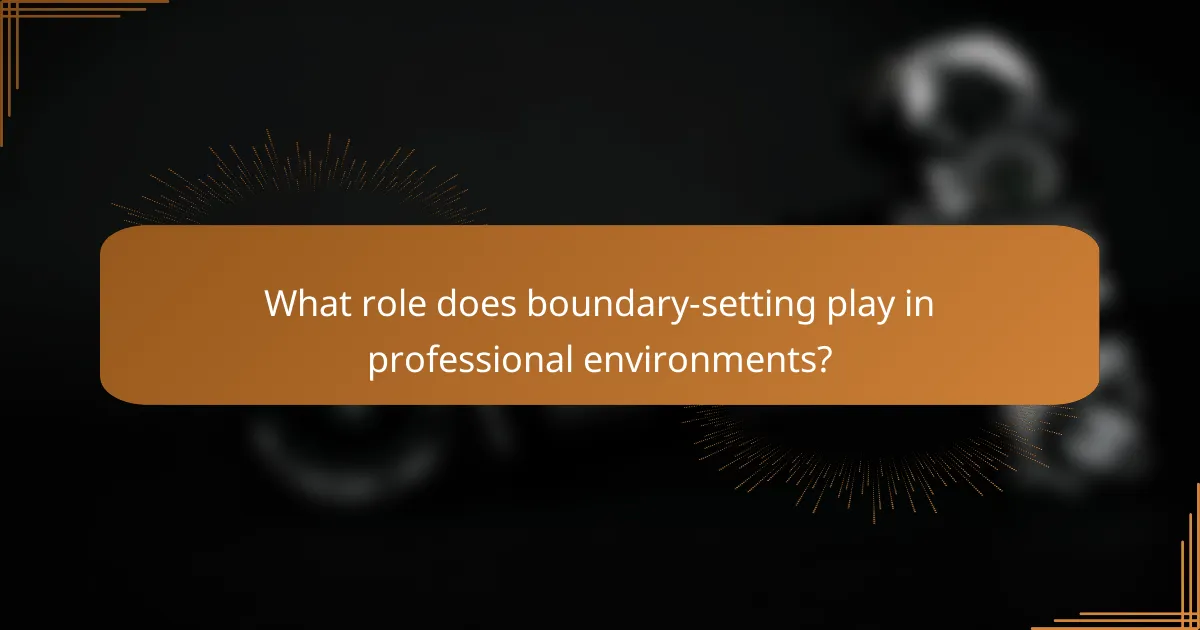
What role does boundary-setting play in professional environments?
Boundary-setting is crucial in professional environments as it helps define acceptable behaviors and limits, fostering a respectful workplace. By establishing clear boundaries, employees can communicate their needs and expectations, leading to improved interactions and productivity.
Enhances workplace respect
Setting boundaries enhances respect among colleagues by clarifying what is acceptable and what is not. When individuals communicate their limits, it encourages others to do the same, creating a culture of mutual respect.
For example, if an employee prefers not to be contacted outside of work hours, clearly stating this can prevent misunderstandings and foster a more respectful relationship with teammates. Respectful interactions contribute to a positive work atmosphere, which can lead to higher employee satisfaction.
Improves team dynamics
Effective boundary-setting improves team dynamics by promoting open communication and collaboration. When team members understand each other’s boundaries, they can work together more efficiently without stepping on each other’s toes.
For instance, if one team member is responsible for a specific task, respecting that boundary allows others to focus on their roles without interference. This clarity can lead to more cohesive teamwork and better project outcomes.
Reduces burnout
Establishing boundaries is essential for reducing burnout in the workplace. When employees set limits on their workloads and personal time, they can maintain a healthier work-life balance, which is vital for long-term productivity.
To prevent burnout, individuals should regularly assess their workload and communicate when they feel overwhelmed. Simple practices, such as taking regular breaks and saying no to additional tasks when necessary, can significantly decrease stress levels and enhance overall well-being.
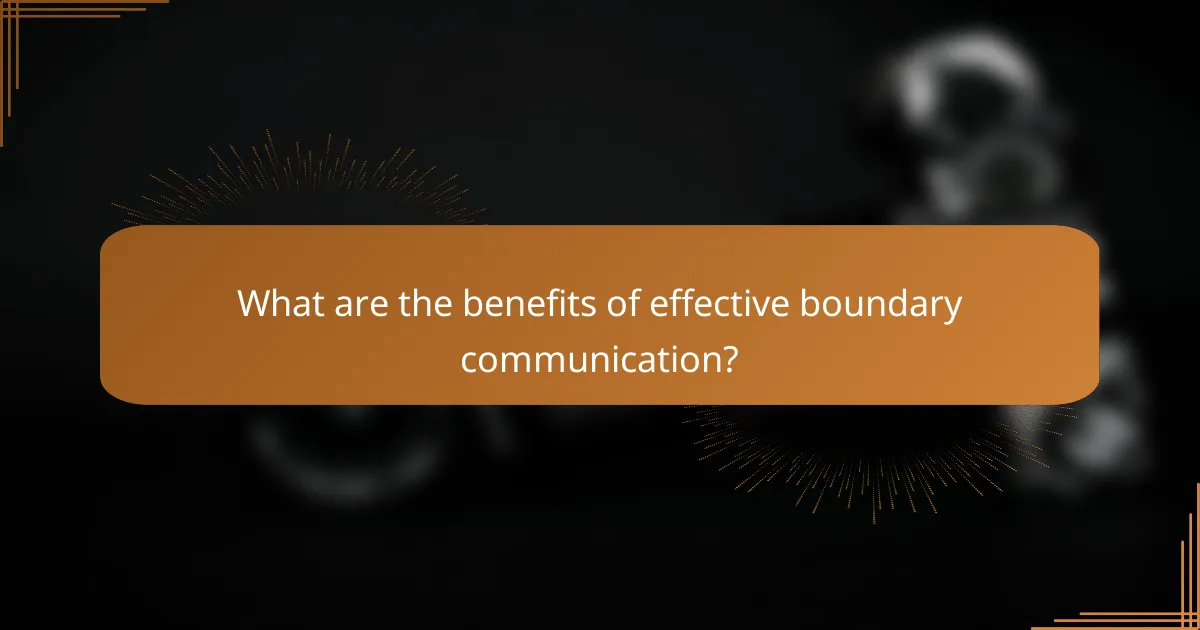
What are the benefits of effective boundary communication?
Effective boundary communication leads to numerous advantages, including improved self-esteem, stronger relationships, and better mental health. By clearly expressing personal limits, individuals can foster respect and understanding in their interactions.
Increased self-esteem
Communicating boundaries effectively can significantly boost self-esteem. When individuals assert their needs and limits, they reinforce their self-worth and confidence. This practice helps to cultivate a sense of control over one’s life and decisions.
To enhance self-esteem through boundary communication, practice saying no when necessary and articulate your preferences clearly. Avoid apologizing excessively for your boundaries, as this can undermine your message.
Better relationships
Establishing clear boundaries is essential for nurturing healthy relationships. When individuals communicate their limits, it fosters mutual respect and understanding, reducing misunderstandings and conflicts. This clarity allows for more honest and open interactions.
To improve relationships, engage in regular discussions about boundaries with friends, family, or colleagues. Use “I” statements to express your feelings and needs, which can help others understand your perspective without feeling attacked.
Enhanced mental health
Effective boundary communication plays a crucial role in maintaining mental health. By setting limits, individuals can protect their emotional well-being and reduce stress. This practice helps to prevent burnout and promotes a healthier work-life balance.
To support mental health through boundaries, regularly assess your limits and adjust them as needed. Recognize signs of overwhelm and take proactive steps to communicate your needs before reaching a breaking point. Prioritize self-care and ensure that your boundaries are respected by others.
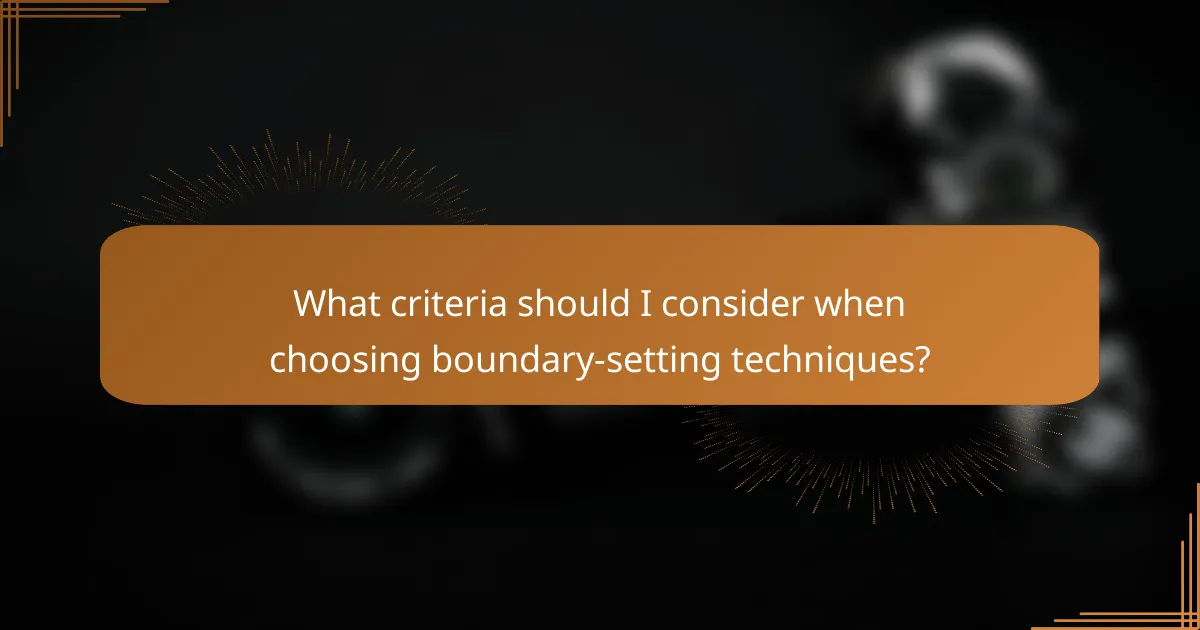
What criteria should I consider when choosing boundary-setting techniques?
When selecting boundary-setting techniques, consider your personal comfort level and the context of the relationship. These factors will guide you in choosing the most effective and appropriate methods for establishing boundaries.
Personal comfort level
Your personal comfort level is crucial when choosing boundary-setting techniques. If you feel uneasy or anxious about a particular method, it may not be the right fit for you. Aim for techniques that align with your values and emotional readiness.
For example, if direct confrontation feels uncomfortable, consider using written communication or gradual verbal approaches. This allows you to express your needs without overwhelming yourself.
Context of the relationship
The context of the relationship significantly influences the choice of boundary-setting techniques. Consider the dynamics, history, and power balance between you and the other person. In professional settings, for instance, maintaining a respectful tone is essential.
In personal relationships, you might opt for a more open and honest dialogue. Understanding the context helps you tailor your approach, ensuring it is both respectful and effective in conveying your boundaries.
